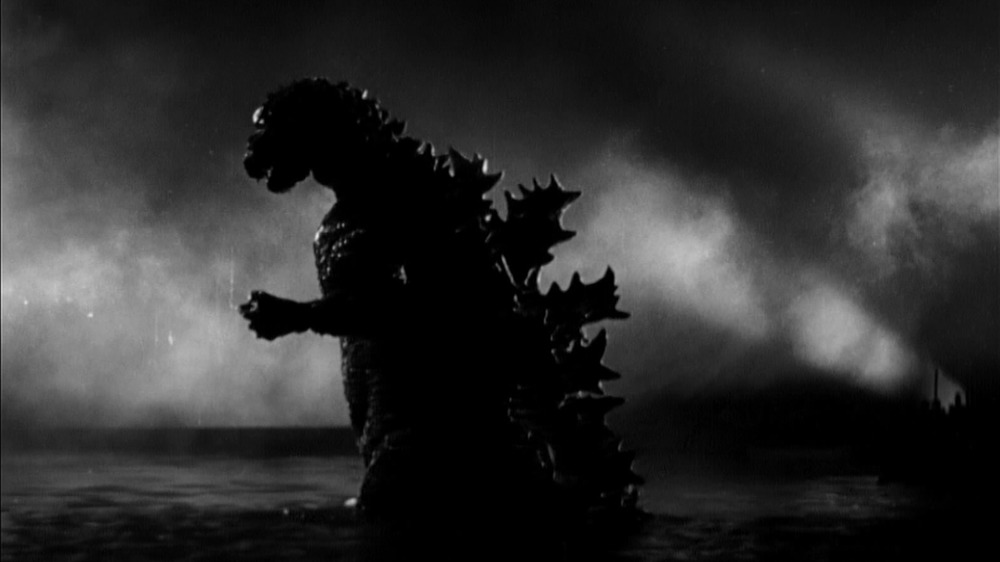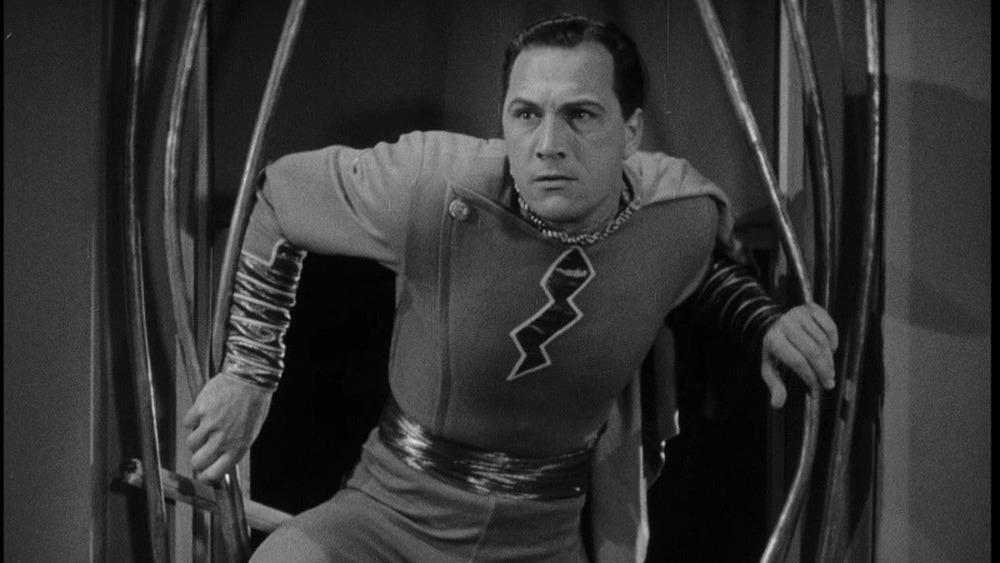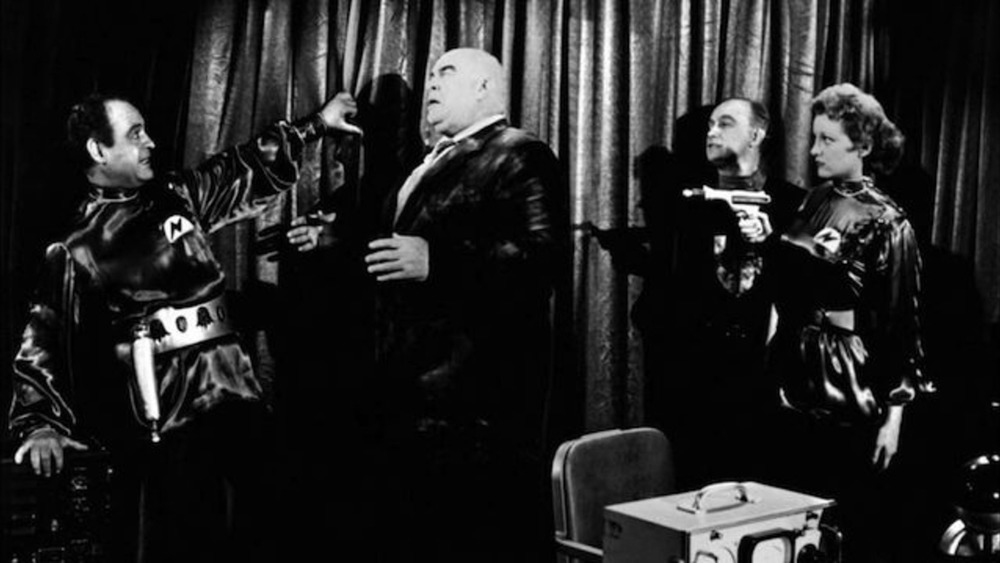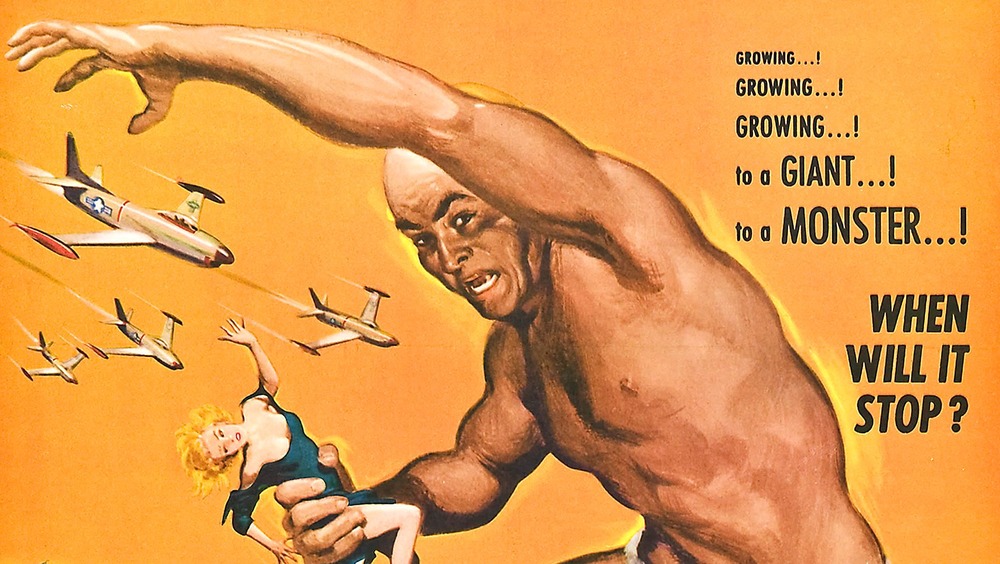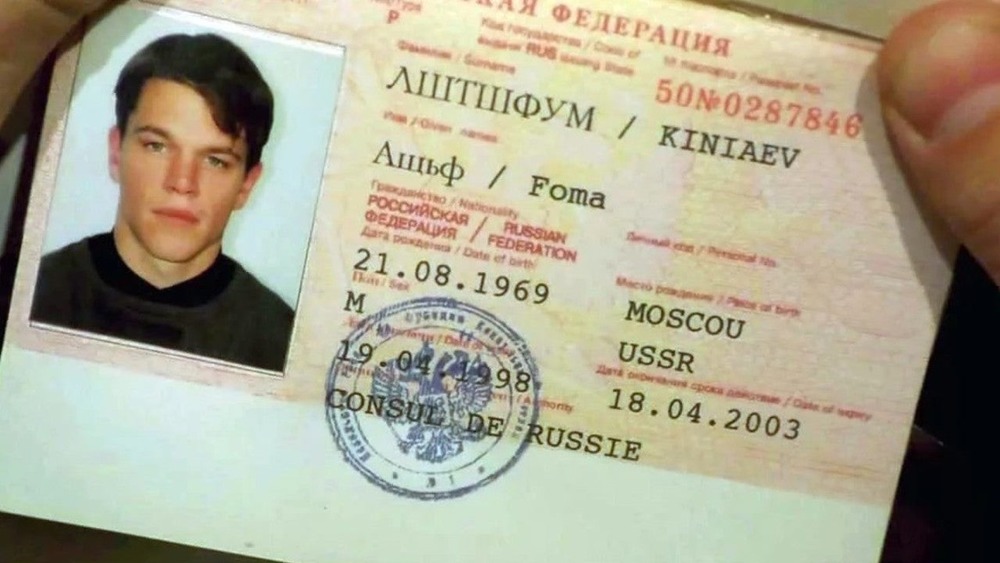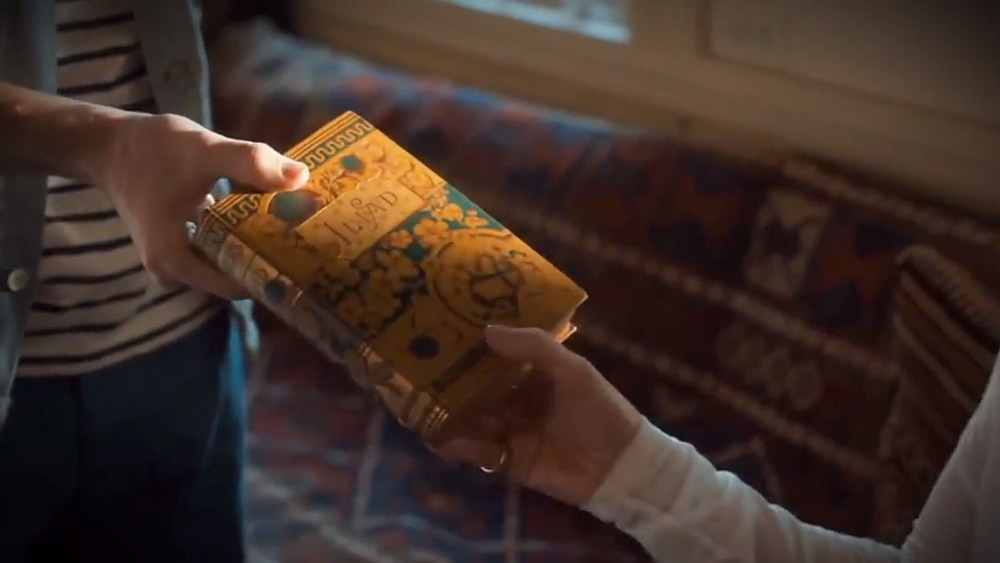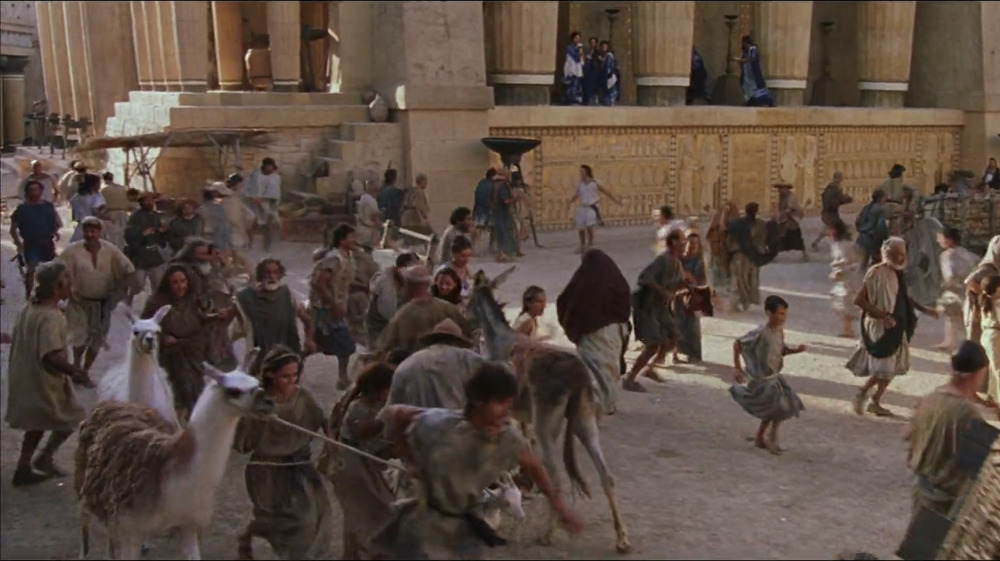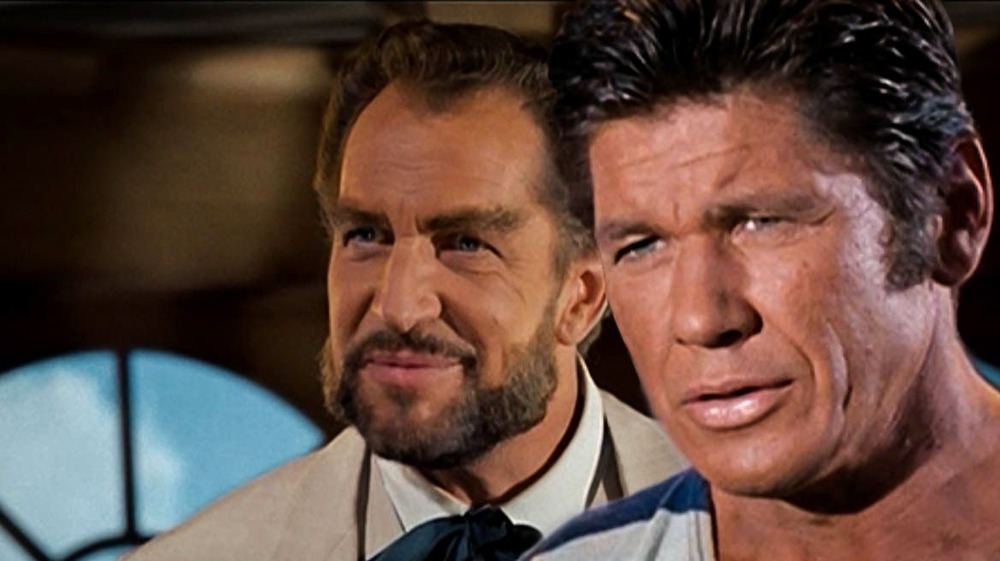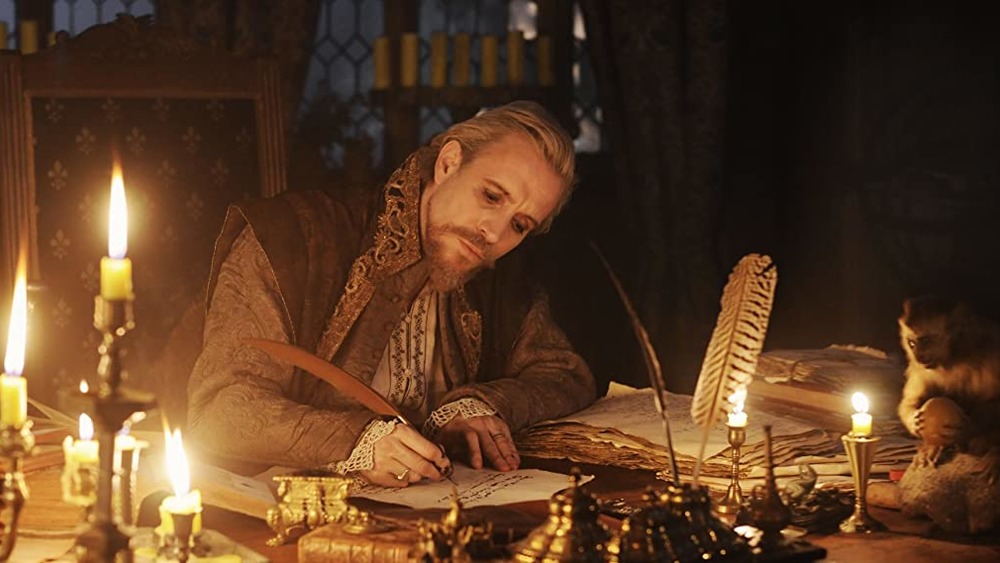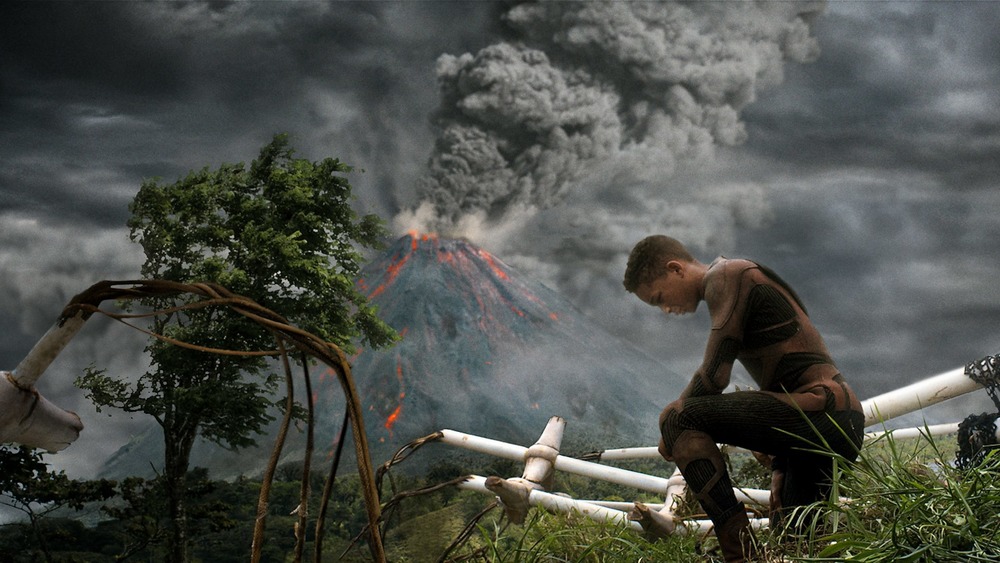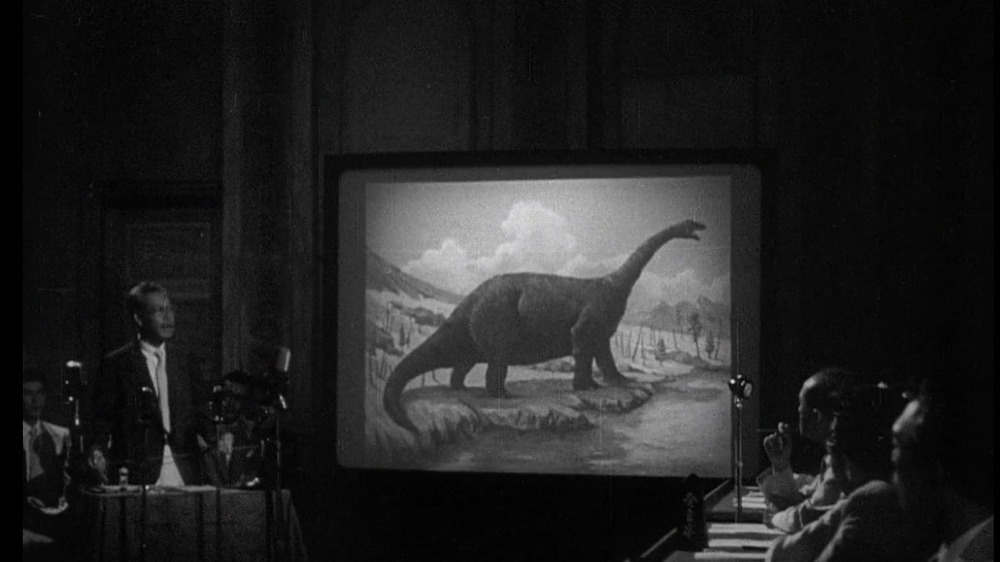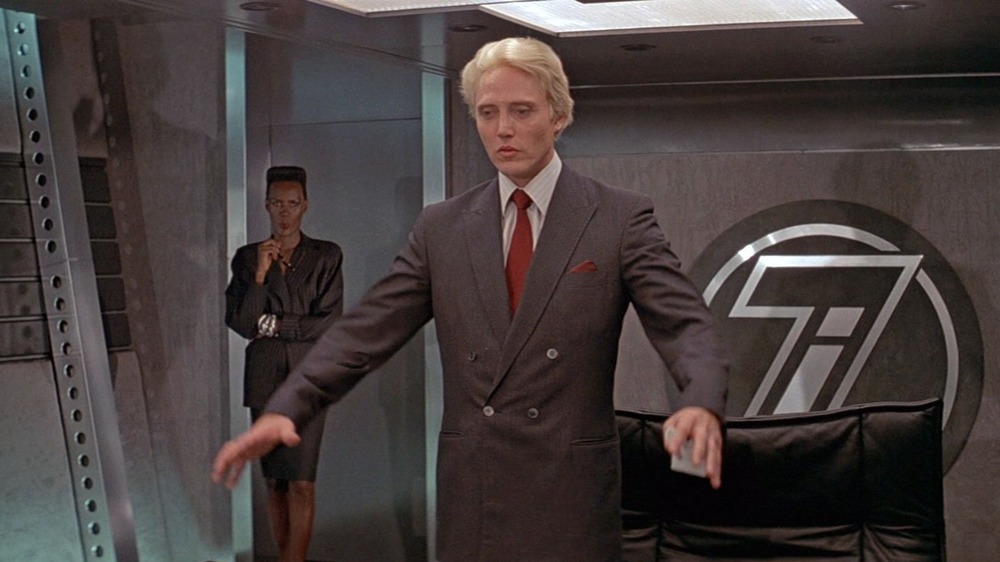The Most Hilariously Obvious Factual Errors In Movie History
The internet is crowded with nerds who'll try to use their knowledge of minutiae to ruin movies for everybody. You know the type — they'll tell you spaceships can't explode because space is a vacuum, that the stars are in the wrong position for a specific hour on a specific night, that velociraptors were really more like killer turkeys. This can be fun, but it can also spoil your enjoyment. And anyway, movies are primarily for entertainment, and if obscure facts get in the way of that, who needs them? Why should studios make creative decisions just to satisfy the few people who know what would happen in real life anyway?
This isn't that. These are the movies full of holes so big even a third grader could spot them. And even if you learn something new reading this article, odds are the filmmakers could have learned it in five minutes if they'd put even a token effort into researching the subjects they're displaying their knowledge of in front of the whole world.
We can't be sure if they were totally unaware of these basic facts or just ignored them in the service of a good story. We honestly can't be sure which is worse, especially since most of these stories aren't even any good to begin with. Here's the most jumbled geography, scatterbrained science, and horribly mangled history we could find at the movies. Here's the most hilariously obvious factual errors in movie history.
The Adventures of Captain Marvel gets Thailand's location way off
Filmmakers work a busy schedule that can't leave a lot of time for reading. And the business requires so much knowledge and skill that maybe it's unfair to expect them to also know everything about everything. But we don't think it's too much to ask them to glance at a map every once in a while.
Apparently, even that was more than the creators of The Adventures of Captain Marvel had in them. Years before Brie Larson or Zachary Levi, Tom Tyler appeared as the crimefighter who'd later be renamed Shazam! in the first superhero movie to ever come out of Hollywood. In it, a reporter named Billy Batson accompanies an archaeological expedition to Siam, where he's trapped in an ancient tomb and rescued by a wizard. The latter gives Billy the powers to keep the mysterious hooded Scorpion from murdering the archaeologists so he can steal the scorpion-shaped weapon they found in the tomb.
The wizard in the original comics was Egyptian, and the writers of Captain Marvel seemed to have no interest in changing the setting beyond the name only. Siam, now called Thailand, is a tropical southeast Asian country that averages around five feet of rainfall every year. You'd never know that from The Adventures of Captain Marvel, which seems to have placed the country somewhere in the Sahara desert. That's true for the turbaned, robed, camel-riding inhabitants Captain Marvel meets there too.
Plan 9 from Outer Space taught us what 'a beam of light' is made of
No one's going to Ed Wood for a science lesson. The legendary director built up a cult after his early death as the worst filmmaker of all time thanks to heavily scare-quoted "classics" like Glen or Glenda?, Bride of the Monster, and, most famously, Plan 9 from Outer Space. In this horror cheapie, aliens plan to invade the earth after weakening our defenses by bringing corpses back to life.
When some intrepid earthlings find the aliens, the alien leader explains that Earth needs to be destroyed for the good of the cosmos. Now that humanity has developed the atom bomb, we'll inevitably develop the "solaranite" bomb, which would explode a ray of sunlight, which "can arrange the total destruction of the entire universe served by our sun."
The humans don't believe it. One says, "Why, a particle of sunlight can't even be seen or measured," but the alien has a snappy comeback: "Can you see or measure an atom? Yet you can explode one. A ray of sunlight is made up of many atoms!"
Except, of course, that's exactly what sunlight isn't made of. It's made of waves of energy. You'd think an alien conqueror from an advanced species would know something we all learn in grade-school science class. Then again, he also seems to think the Earth's sun lights the whole universe, so maybe he's just not all that bright.
The Amazing Colossal Man claimed 'the human heart is one big cell'
In the '50s, the movie industry needed a steady stream of cheap sci-fi movies to keep the drive-in theaters full, and that meant quantity over quality. Audiences didn't see these movies for education, unless it was teaching their dates about the birds and the bees. The Amazing Colossal Man was no different, with a disbelief-stretching story in which a man caught in the blast of an experimental plutonium bomb starts growing because his cells won't stop reproducing.
If we were feeling more nitpicky, we could bring up all sorts of stuff about the square-cube law and how the human body wasn't designed to support that much weight, or even the question of how the amazing colossal man grows out of all his clothes but not the little white diaper that kept the movie from being rated X. Yet the average viewer doesn't know or care about all that. Sometimes, you just wanna see a really big guy smash some stuff.
But even the most science-challenged viewer can't help wondering if they heard one line of dialogue right. One of the scientists studying the colossal man explains that his mutation could be fatal. His heart isn't growing fast enough to support the rest of his giant body because "the human heart is one big cell." That's so staggeringly wrong that the only words for it are the ones Crow T. Robot used on Mystery Science Theater 3000: "You're not a real doctor, are you?"
Jason Bourne's Russian passport is unpronounceable gibberish
Even the most expensive, professional Hollywood productions aren't immune to these kinds of embarrassing errors. The Jason Bourne series is about as professional as it gets, with Matt Damon starring as Jason Bourne, a CIA super-assassin who wakes up floating in the Mediterranean with no knowledge of who he is or how he got to be so good at killing people. The CIA hasn't forgotten though, and Bourne has to spend the first three movies trying to stay ahead of them. The series set new standards for gritty realism in action movies, but there's at least one scene that has no resemblance to reality at all.
Bourne discovers his handlers have left him passports for many countries, including Russia. It looks good enough if you don't speak the language, but we have to imagine The Bourne Supremacy briefly turned into a comedy in every Russian theater when this scene came on. The Cyrillic characters on the passport don't spell "Jason Bourne" or any appropriate Russian alias. They don't spell much of anything at all — the best transliteration we could come up with is "LSHTSHFUM." Good enough to fool American audiences, maybe, but we have to imagine Bourne would get hauled off to a windowless office before he knew what hit him if he ever tried to show that at the Russian customs desk.
The Boy Next Door dug up a first edition of a millennia-old book
The Boy Next Door stars Jennifer Lopez as Claire Peterson, a high school literature teacher who has a one night stand with a student named Noah (Ryan Guzman). It's all downhill from there, as Noah tries to seduce Claire before graduating to stalking and eventually blackmail, assault, and kidnapping.
Some of Noah's seduction techniques are more than a little odd, though. At one point, he drops by with a gift for Claire he found at a garage sale: The first edition of The Iliad. As anyone who passed, let alone teaches, high school lit should know, The Iliad is one of the oldest works in literary history. So you'd expect an English teacher to gently correct Noah, but instead she says, "I can't accept this! It must have cost a fortune."
The internet jumped on this scene immediately, and it's a major reason The Boy Next Door is in line to join the canon of "So Bad It's Good" movies. It's not too hard to give the writers the benefit of a doubt — maybe they meant this was the first edition of that specific translation (which some sleuthing by the LA Times reveals was the classic 19th-century version by Alexander Pope). Still, it's probably a good sign of how silly your movie is when most of your audience immediately assumes you think first editions of Ancient Greek texts are hanging around suburban yard sales.
Troy puts llamas on the wrong side of the Atlantic
Some mistakes are subtle enough that it's easy to see how audiences could miss them — but major enough that it's harder to see how the filmmakers could. In 2004, Troy retold the story of the Trojan War from Homer's Iliad and many other Ancient Greek sources with stars like Brad Pitt and Orlando Bloom. It plays fast and loose with the source material, drastically straightwashing Homer's text of Achilles fighting to avenge his male companion, while the gods who play such a major role in every other telling are nowhere to be found. But the strangest discrepancy of all is easy to miss. One crowd scene includes a farmer leading some llamas through the square.
Llamas, of course, come from South America, which Europeans wouldn't make contact with for thousands of years. So how did they get to ancient Troy? This strange choice only gets stranger the more you think about it. Even if the filmmakers somehow didn't know there were no llamas in Troy, as an anonymous TV Tropes editor points out, Troy really was filmed on the Mediterranean. Someone must have had to go out of their way to ship llamas from across the Atlantic. How did no one anywhere in that process realize that this meant llamas didn't belong there?
In Master of the World, the views from the air and the ground are the same
Vincent Price stars in Master of the World as Jules Verne's anti-hero Robur the Conqueror, an airborne pirate who flies a massive, blimp-like airship and dreams of peace on earth, even if he has to bomb everyone into the Stone Age to get it. Master of the World was a play at prestige for B-movie factory American International Pictures with its big-time stars, including Price and Charles Bronson, and flashy special effects. The studio spent more than they were used to in creating the spectacular images of Robur's flying arsenal. But they didn't take nearly as much care on the easy stuff.
Robur's airship has a big window in front, and we get a good look through it as Robur mans the steering wheel. There's one problem — the footage the filmmakers matted in behind it doesn't even begin to match the location of the airship in the exterior shots. One scene cuts between the airship floating high above the ocean, as it bombs a ship, and the interior, where the horizon is so high Robur looks like he's about to nosedive into the ocean any second. In other scenes, he looks through a periscope, which somehow shows him everything at ground level. Almost as if he's not really flying above it at all and he's just looking at footage filmed by a studio too cheap to spring for a helicopter!
Anonymous proves Roland Emmerich doesn't understand poetry OR botany
Roland Emmerich makes movies that stomp on realism in so many ways we can't even begin to run through all of them. The Day After Tomorrow asked what would happen if global warming somehow made things colder. 10,000 BC put the Arctic next to a jungle next to a desert. But it's no fair ragging on those movies. We watch them for some dumb fun, not to learn anything. That said, this should give you some idea how far off Emmerich gets when he does try to teach us something.
Anonymous promises the true story behind Shakespeare's plays, claiming he took credit for the work of Edward De Vere, Earl of Oxford (Rhys Ifans). But the events onscreen don't line up. In one scene, De Vere picks a physically impossible half-red, half-white Tudor rose. This was actually just a family symbol — there's no evidence anyone's ever been able to grow one. (You'd think the fact Emmerich had to call in the special effects boys to mock one up should have been a clue...)
Worse, Shakespeare's rivals, including Christopher Marlowe and Thomas Nashe, are jealous he could write a whole play in verse. "I could do if I wanted to," Nashe scoffs, but when asked if he ever tried, he says, "Of course not." Well, he did, as did all of them — in Shakespeare's time, as video critic Kyle Kallgren points out, a verse play was no more special than a rhyming rap.
After Earth flunked out of every science class
While promoting After Earth, Will Smith said, "At heart, I'm a physicist." Maybe, but only at heart, if the movie (which he was heavily involved in conceiving) is anything to go by.
Smith stars as Cypher Raige, a soldier from a civilization humans built on another planet 1,000 years after abandoning Earth. One day, he and his son Kitai, played by Smith's real-life son Jaden, crash land on their ancestral home. Cypher is too seriously injured to light the distress beacon that landed miles away, so Kitai must trek across the wilderness to find it. It's a dangerous mission — as Cypher warns his son, "Everything on this planet has evolved to kill humans."
This line was featured heavily in the trailers because it sounds cool, but it falls apart the second you think about it. First and most obviously, why would everything evolve to kill something that hasn't been there for 1,000 years? And 1,000 years may sound like a lot, but it's a blip in evolutionary time. It would take thousands times thousands of years for the animals we know to develop into the giant monstrosities Kitai has to fight.
It gets worse. Somehow, over this relatively tiny timespan, the whole environment of Earth has changed — blazing hot all day, freezing cold all night — yet somehow the planet is covered in lush jungles even though the nightly freeze should kill them all off once every 24 hours.
Godzilla gets the age of the dinosaurs off by a couple of zeroes
The Godzilla movies aren't serious enough to worry too much about real-world facts. They're full of ridiculous concepts like a robot who somehow turns into a giant by monkeying with his own programming or a cute baby version of the Big G. That's all part of the fun.
It's also a long way from where the series started in 1954, a deadly serious and downright horrifying meditation on the horrors of the atomic bomb in the wake of the destruction of Hiroshima and Nagasaki. But even that movie flubs the facts in one very big way. Scientist Kyohei Yamane (Takashi Shimura) explains his theory that Godzilla is a dinosaur awakened by atomic tests by giving some background on the primordial age: "Approximately two million years ago, the brontosaurus and other dinosaurs were at their peak. Scientists call this the Jurassic Age."
Anyone who grew up obsessing over dinosaurs is probably all set to jump in and correct him already, but for some context — the Jurassic Age is just one period within the longer Mesozoic period when the dinosaurs lived. More importantly, the brontosaurus has been extinct for 145 million years. To put that in perspective, imagine if a waiter told you your dinner would be ready in two minutes and instead you got stuck waiting two and a half hours. That's roughly the disappointment dino fans must have felt watching this scene.
The villain's plan in A View to a Kill would hurt him the most
Villains' plots in James Bond movies aren't exactly noted for their rigorous logic. We expect them to give us over-the-top nonsense full of diamonds, death rays, and exploding sharks so they can blow up the Earth or irradiate all the gold in Fort Knox. But some Bond villains stretch even this series' bounds of plausibility, none more than Max Zorin in A View to a Kill. He's played by Christopher Walken, and it should tell you something that a movie can have such brilliant casting and still be one of the most hated in the series.
That probably has something to do with the plot. Zorin's master plan is to blow up the San Andreas Fault so he can sink California into the ocean. Why? Because he manufactures computer chips and wants Silicon Valley out of the way so he can corner the market. If that seems off to you, that's because you have a vague awareness of what Silicon Valley is, which is apparently more than the writers ever had. As Roger Ebert points out, no one in Silicon Valley makes computer chips. They make computers, and buy the chips from companies like Zorin's. In other words, if Zorin's plan worked, he wouldn't have destroyed his competitors, he'd destroy his own business! Makes you wonder if he should thank Bond for stopping him.
